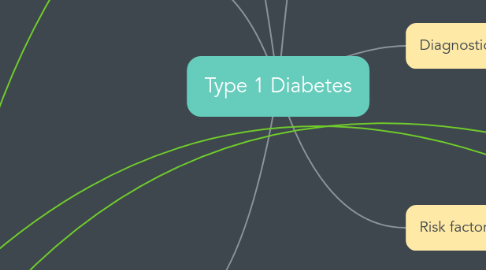Type 1 Diabetes
da Cara Discepoli


1. Gillespie, K.M. (2006). Type 1 diabetes: pathogenesis and prevention. Retrieved September 26th from https://www.ncbi.nlm.nih.gov/pmc/articles/PMC1489998
2. Treatment
2.1. Insulin
2.1.1. Short-acting (regular) insulin
2.1.1.1. Humulin R
2.1.1.1.1. Novolin R
2.1.2. Rapid-acting insulin
2.1.2.1. Apidra
2.1.2.1.1. Novolog
2.1.3. Intermediate-acting insulin
2.1.3.1. Insulin NPH
2.1.4. Long-acting insulin
2.1.4.1. Levemir
2.1.4.1.1. Tresiba
2.2. Monitor blood sugar frequently
2.3. Count carb, fat, and protein intake
2.4. Eat healthy foods
2.5. Exercise frequently and maintain healthy weight
2.6. High blood pressure medications
2.6.1. ACE inhibitor
2.6.1.1. Angiotensin II receptor blocker
2.7. Aspirin
2.8. Cholesterol lowering drugs
3. Incidence/Prevalence
3.1. Genetic
3.2. Global variations
3.3. Diamond project conducted in 2000
3.3.1. Found that children under 14 years of age in 50 countries worldwide total 19,164 cases from a population of 75.1 million children
3.4. Young children
3.5. Girls and boys equally affected
4. Type 1 diabetes. (2017). Retrieved September 26, 2017, from http://www.mayoclinic.org/diseases-conditions/type-1-diabetes/diagnosis-treatment/diagnosis/dxc-20340995
5. Diabetes symptoms: early warning symptoms & signs of diabetes. (N.d.). Retrieved September 26, 2017, from http://www.jdrf.org/tld-resources/symptoms/.
6. Maahs, D.M., West, N.A., Lawrence, J.M., & Mayer-Davis, E.J. (2010). Chapter 1: epidemiology of type 1 diabetes. Retrieved September 26, 2017, from https://www.ncbi.nlm.nih.gov/pmc/articles/PMC2925303
7. Signs and symptoms
7.1. Increased thirst
7.2. Frequent urination
7.3. Extreme hunger
7.4. Unintended weight loss
7.5. Mood swings or irritability
7.6. Fatigue
7.7. Blurred vision
7.8. Extreme thirst
7.9. Diabetic ketoacidosis
7.9.1. Dry mouth
7.9.1.1. Stomach pain
7.9.1.1.1. Flushed face
7.10. Slow-healing cuts
7.11. Yeast infection
8. New node
9. New node
10. Pathogenesis
10.1. Results from autoimmune destruction of insulin-producing B cells in the pancreas
10.2. Both genetic and environmental factors precipitate the disease
10.3. The human leukocyte antigen on chromosome 6 is known to be associated with type 1 diabetes
10.4. The second most important gene noted to contribute to type 1 diabetes is chromosome 11, an insulin gene
11. Risk factors
11.1. Type 1 diabetes is prevalent in young children mostly
11.2. The greatest incidence of type 1 diabetes is in low-incidence countries of Eastern Europe
11.3. Some viruses such as enteroviruses, rotavirus, and rubella are suspected to lead to type 1 diabetes
11.4. People with 2 or more islet cell antibodies are shown to have the highest prevalence for type 1 diabetes
12. Diagnostics
12.1. Glycated hemoglobin (A1C) test
12.1.1. A1C level of 6.5 percent or higher indicates diabetes
12.2. Random blood sugar test
12.2.1. Blood sugar of 200 mg/dL or higher indicates diabetes
12.3. Fasting blood sugar test
12.3.1. Blood sugar level of 126 mg/dL indicates diabetes
